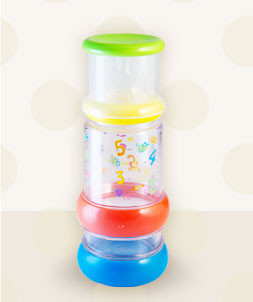
I admit to being one of those consumers that sees “BPA-free” on a label and immediately feel at ease. The harmful effects of Bisphenol-A are well known, and manufacturers have found alternative plastic chemicals in response to consumer demand. The problem is many of these replacement chemicals are just as scary to our health as BPA. We discovered one such scary chemical Tritan in a product we were sent to review that is a convenient multi-stage zippy cup called [amazon_link id=”B00FXPSEZA” target=”_blank” ]Take n’ Shake[/amazon_link]
bouche baby Take n’ Shake is BPA-free, doctor approved, and uses a colic prevention nipple.
Multi-Stage
- TAKE N’ SHAKE Feeding Bottle with Integrated Formula Compartment
- Standard feeding bottle
- Use with milk, water or juice
- Makes transition from bottle to sippy cup easier
- Conversion kit sold separately
- Additional formula compartments (TAKE 2) sold separately
- Additional nipples (0-3 months, slow flow, 3-6 months, medium flow, 6+ months, fast flow) sold separately
Easy to Use
- Quick and easy assembly
- Leak proof and mess free
- Dishwasher safe and easy to clean
Ulta Safe
-
State-of-the-Art Tritan™ is BPA-free (made without bisphenol-A), does not contain any harmful chemicals or toxins, and provides increased durability and clarity
-
Colic prevention nipple made from naturally soft medical grade silicone
-
Unique design ensures no formula contamination
Take n’ Shake says right on the label “ultra-safe”; however, that is only if you believe Tritan is safe. The above description says Tritan “does not obtain any harmful chemicals or toxins”, but researchers have found otherwise. Mother Jones reported back in March (and we wore about this new research confirming BPA-free plastics are not safe):
One of the most popular BPA-free options, especially among companies catering to families and health-conscious consumers, was Tritan, a clear, sturdy, heat-resistant plastic that Eastman rolled out in 2007. (Eastman also produces the chemical that sullied the drinking water of 300,000 West Virginians in January.) A company founded by alternative medicine guru Dr. Andrew Weil launched a line of Weil Baby bottles made from Tritan, which it touted as “revolutionary” and “ultra-safe” material. Thermos began churning out Tritan sippy cups, decorated with Barbie and Batman. With more and more consumers demanding BPA-free products, Nalgene, CamelBack, Evenflo, Cuisinart, Tupperware, Rubbermaid, and many other companies also worked Tritan into their production lines.
Eastman, a $7 billion company that was spun off from Eastman Kodak in the 1990s, assured its corporate customers that it had done extensive safety testing on Tritan. But its methods were questionable. According to internal Eastman documents, in 2008 Eastman signed a two-year contract with Sciences International, another product defense firm that had played a key role in the tobacco industry’s scientific misinformation campaign. On Sciences’ advice, Eastman then commissioned a study that used computer modeling to predict whether a substance contains synthetic estrogens, based on its chemical structure. The model suggested that one of Tritan’s ingredients—triphenyl phosphate, or TPP—was more estrogenic than BPA.
Eastman, which never disclosed these findings to its customers, later commissioned another study, this one involving breast cancer cells. Again, the initial results appeared positive for estrogenic activity. In an email to colleagues, Eastman’s senior toxicologist, James Deyo, called this an “oh shit moment.”…
Eastman wasn’t the only company testing Tritan. In 2009, Bittner’s PlastiPure, which was searching for nonestrogenic alternatives to recommend to clients, began vetting products made with it and found that some had even more estrogenic activity than their BPA-laden counterparts. PlastiPure’s CEO, Mike Usey, says CertiChem disclosed this to clients, but many chose Tritan anyway…
DESPITE ITS “OH SHIT” FINDINGS, by 2010 Eastman began to produce marketing materials claiming that Tritan was free of all synthetic estrogens. One section of its website featured the tagline “Safety is our key ingredient” along with photos of smiling children eating and drinking out of plastic containers. The site claimed “third-party research” had shown Tritan to be free of estrogenic activity, but when corporate customers tried to verify this information, Eastman grew cagey. In early 2010, Philips Avent, a top producer of baby bottles and sippy cups, inquired about having an outside lab run testing on Tritan. Eastman’s senior chemist Emmett O’Brien fired off an email to colleagues, saying, “We need to [do] everything possible to convince the customer NOT to do EA [estrogenic activity] testing.” Philips was persuaded. But, according to testimony from Eastman executives, that same year Nestlé vetted Tritan, and found it leached synthetic estrogen. (Frédérique Henry, a spokeswoman for Nestlé, acknowledges the company tested Tritan but denies the results were positive.) Nestlé has nevertheless continued using Tritan in some of its water bottles.
As I have advised before, it’s best to avoid as much plastic as possible. It is bad for our environment; it is a bad for our health. I not convinced there is a way to make plastics safely. Just because something says BPA-free, do not assume it is safe for your family. In fact, Tritan may be scarier!
[amazon_enhanced asin=”B00FXPSEZA” /].
Disclosure: The products described above were sent to us as free samples. Prior assurances as to the nature of the reviews, whether positive or negative, were not given. No financial payments were accepted in exchange for the reviews. The reviews reflect our honest, authentic opinions
